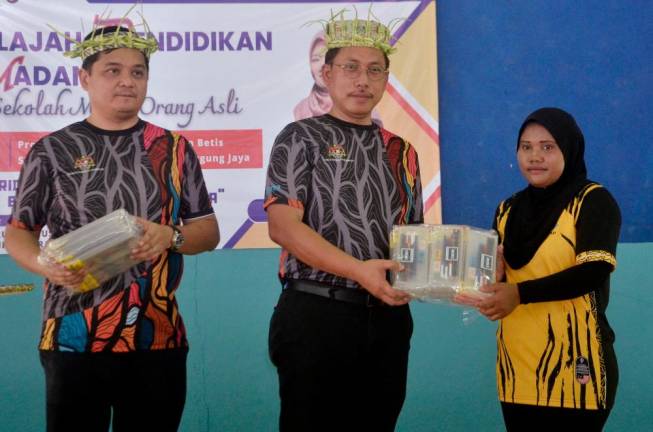DURING the last fortnight a poster was doing the rounds to announce a congress with the title of “Maruah Melayu”. Four universities were reported to be involved in putting together yesterday’s event.
Since the organisers appear to be associated with Parti Pribumi Bersatu Malaysia, there has been predictable flak from the opposition camp. Umno vice-president Datuk Seri Mohamed Khaled Nordin has questioned why public universities are being used to promote the event and has argued that if the congress was being organised to address the problems of the Malay race, public universities should not be the organisers.
According to him, “Isn’t the national task and focus of such higher learning institutions based on developing, expanding, exploring and to improve one’s knowledge? Instead of being the ones championing the Malays and their exclusive interests.”
Khaled is wrong on at least one score. Universities around the world routinely engage in analysing public policy and other subjects of popular or academic interest including on race, religion, etc.
Most do this independently. What they do not and should not do is become handmaidens or acolytes of political parties or political leaders.
Debate on social stereotyping
The subject of Malay dignity is an important one to understand not only because it is a complex and deep socio-cultural phenomenon but also because it is regarded by many members of the community as under threat or being undermined. Hence it has been associated with many developments including a boycott of non-Malay products; Zakir Naik’s residency; the death of fireman Muhammad Adib; and the rejection of ICERD.
Although it is a subject which Umno and PAS probably have few rivals in exploiting during the past 50 years, it would be interesting to see how the Pakatan government makes use of the congress and its findings for the larger national rather than narrow politically oriented ethnic advantage.
Scholars examining the subject have noted its close relationship to the sense of “malu” and “nama” as well as the sense of self-protection and potential for retaliation. Will the congress be used to reinforce a sense of racial and religious entitlement and superiority?
In exploring this complicated subject, politicians and others may want to take note of the debate taking place on the issue of success and failure among various racial groups in other parts of the world which have a bearing on the sense of social standing, self esteem and reputation.
An article on The Asian Advantage by Nicholas Kristof, a New York Times columnist analysed why Asian Americans are successful in America, earning more than other groups including whites as well as having higher levels of educational attainment.
The article drew on a book The Asian American Achievement Paradox, by Jennifer Lee and Min Zhou, which noted that Asian American immigrants have started with one advantage: they are highly educated, more so even than the average American, and are disproportionately doctors, research scientists and other highly educated professionals.
And the success is not confined to the highly educated. The children of working-class Asian Americans often also thrive, showing remarkable upward mobility. Lee and Min Zhou posit that positive stereotyping may be a partial explanation for the success of Asian Americans in school.
While stereotyping is hard on Asian American children whose comparative advantage is not in science or maths, the interaction of social stereotypes, hard work and self-confidence have led Lee and Zhou to argue that Asian Americans sometimes ride on the opposite of “stereotype threat”, – that is, a “stereotype promise” that they will be smart and hard-working.
In contrast, scholars have found that blacks sometimes suffer from “stereotype threat” – ie anxiety from negative stereotypes which impairs performance.
Explaining the Malay disadvantage
It may be contentious to compare findings of racial differences across countries in view of distinctive national features. But some key points in that article may be relevant as we grapple with the subject of racial attainment and what has been made out to be the non-Malay advantage or Malay disadvantage. They are summarised with my own observations in italics.
» Any difference in racial achievement or attainment is not driven by differences in intelligence. This is self-evident. However it needs to be put into the forefront of any discussion on racial differences because of the mistaken belief that racial differences are somehow explained by hereditary or genetically determined factors such as intelligence. Thus we have the flawed argument on the key role of genetic factors in explaining Malay backwardness and racial differences in the highly influential book, The Malay Dilemma.
» There is a focus on education. Immigrant East Asians try particularly hard to get into good school districts, or make other sacrifices for their children’s education. This explains why many non-Malay parents support the vernacular schooling system which is seen as superior to the Sekolah Jenis Kebangsaan. Many Malay parents also know the importance of good schooling: hence the fight for places in Mara junior colleges which are open to a small proportion of students; and to avoid the SK secondary schools which are seen as of lower standard.
» Strong two-parent families are a factor, too. Divorce rates are lower for many Asian American communities than for Americans, and there is evidence that two-parent households are less likely to sink into poverty and have better outcomes for boys in particular. This subject of marriage, divorce, single mothers and small families – as well as other cultural factors – may be critical to understanding the dynamics of educational attainment, socio-economic mobility, poverty and other related subjects in Malaysia. That it continues to be neglected means that wrong or muddled policies and ineffective outcomes will be the norm.
The article ends with an important observation. “Disadvantage and marginalisation are complex, often deeply rooted in social structures and unconscious biases, sometimes compounded by hopelessness and self-destructive behaviours ...”
What ultimately shapes maruah
One would have expected that one of the most wide-ranging, expensive and long lasting racial affirmative programmes the modern world has seen should have led to more positive and sustainable outcomes for the Malay community.
Admittedly the NEP has had tremendous success as seen in the wealth and educational achievements of the Malay elite and middle class.
But why have so many Malays remained disadvantaged has mystified numerous national economic congresses. Clearly they have been looking for the solutions in the wrong places.
In an earlier exchange on the subject, the late Kassim Ahmad had written:
All racial groups cannot remain toddlers for more than a few years. At some appropriate point, they must stand on their own. The apron strings must break loose. Otherwise they will be forever disadvantaged. Although I am Malay, I am arguing for the ending of so-called Malay special privileges. They must appropriately change their philosophical outlook and work harder.
Culture, family structure, social psychology, value systems – all these interact to produce individuals and communities that are successful or need propping up.
Until the government, think tanks and the Malay intelligentsia place these in the forefront of public policy, they will continue to run around in circles looking for the answer to enhancing Malay maruah and ending Malay disadvantage.
This article is the eleventh in the series on the state of Malay dominance. Comments: letters@thesundaily.com















